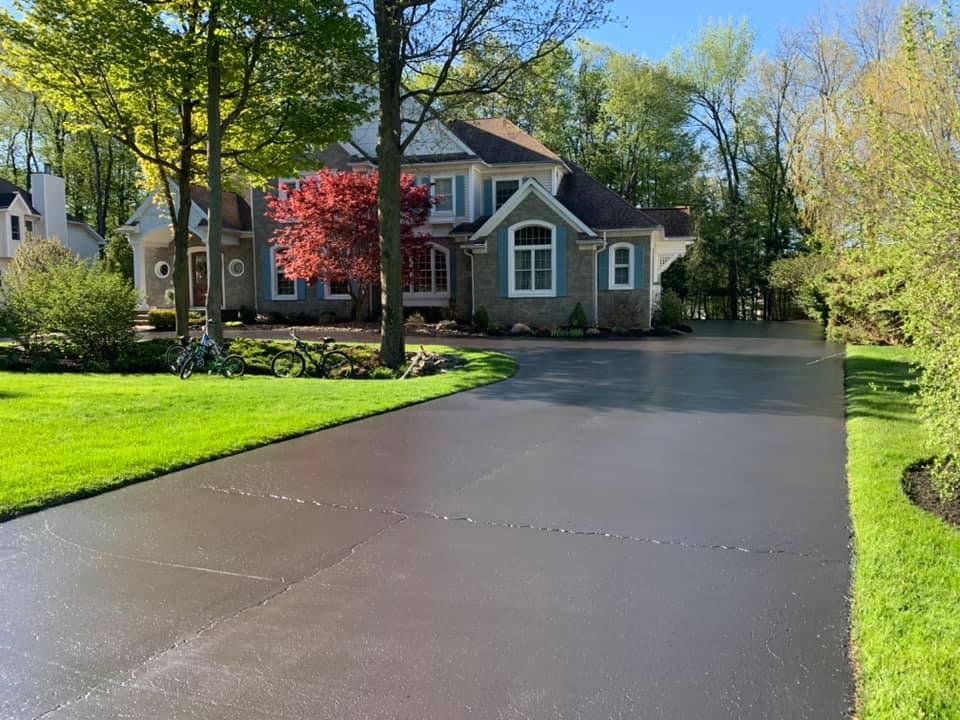Maximize Financial Investment Returns: Angled Parking Lot Excellence with Asphalt Sealing
Wiki Article
Warm Mix Asphalt: A Lasting Solution for Sidewalk
Hot Mix Asphalt (HMA) has actually become a leading sustainable choice for pavement options, offering a myriad of ecological benefits and innovative modern technologies. Its capability to recycle materials and reduce energy intake offers a compelling case for its adoption in roadway building projects. Moreover, the lasting efficiency and longevity of HMA make it a preferred alternative for framework growth. As the need for green construction techniques grows, discovering the subtleties of HMA's sustainability can offer important insights right into the future of sidewalk options.Ecological Benefits of Hot Mix Asphalt

In Addition, Hot Mix Asphalt aids to mitigate metropolitan warm island impacts. Its dark color soaks up sunlight, lowering the amount of warmth reflected back into the atmosphere compared to lighter-colored sidewalks. This can reduce ambient temperatures in urban locations, decreasing the demand for a/c and eventually reducing power usage.
In enhancement, Hot Mix Asphalt adds to enhanced stormwater monitoring. Its permeable nature permits water to recharge and infiltrate the pavement groundwater products, reducing overflow and the threat of flooding. These environmental benefits make Hot Mix Asphalt a lasting option for paving freeways and roads.
Energy Performance in HMA Manufacturing
Is energy efficiency a critical aspect in the production of Warm Mix Asphalt (HMA)? Power plays a significant duty in the manufacturing of HMA, impacting both price and ecological sustainability. One crucial element of energy effectiveness in HMA manufacturing is the use of cozy mix asphalt (WMA) innovations.In addition, innovations in plant modern technologies have resulted in even more energy-efficient HMA manufacturing processes. Modern plants are developed with features like recycled asphalt pavement (RAP) processing abilities, efficient burner systems, and boosted insulation, all adding to power cost savings. By maximizing energy use in HMA production, the sector can reduce its carbon footprint while keeping top quality pavement materials. Power performance is, for that reason, a critical consideration in guaranteeing the sustainability of Warm Mix Asphalt manufacturing.
Recyclability of Warm Mix Asphalt
The recyclability of Hot Mix Asphalt (HMA) is a pivotal facet of its sustainability and long-term ecological effect. HMA is one of the most recycled materials in the USA, with over 100 million lots of reclaimed asphalt sidewalk (RAP) being reused annually in new sidewalk building and construction. Recycling HMA offers several environmental advantages, such as lowering the need for virgin materials, lowering energy consumption throughout manufacturing, and lowering the amount of waste sent to landfills.The process of recycling HMA entails crushing the existing sidewalk, squashing it right into smaller items, and mixing it with new aggregate and asphalt binder to develop a recycled mix. This recycled mix can typically perform as well as or perhaps much better than traditional HMA, while calling for fewer basic materials and producing reduced greenhouse gas exhausts. By integrating RAP right into brand-new pavement projects, roadway companies can preserve natural deposits, minimize costs, and minimize the ecological footprint of roadway construction and upkeep tasks. Generally, hot mix asphalt the recyclability of HMA plays a significant duty in promoting sustainable practices within the pavement sector.

Long-Term Efficiency of HMA
Asphalt sidewalks demonstrate toughness and resilience over an extended duration, reflecting the long-term efficiency of Hot Mix Asphalt (HMA) Additionally, improvements in HMA technology, such as the use of polymer-modified binders and warm mix asphalt, have actually further improved the durability and long life of HMA pavements. By focusing on high quality building and upkeep techniques, HMA continues to prove itself as a cost-effective and sustainable service for resilient sidewalk framework.
HMA: Sturdiness and Sustainability
Demonstrating both longevity and sustainability, Hot Mix Asphalt (HMA) has come to be a foundation in the building and construction of lasting sidewalk frameworks - commercial parking lot paving. HMA's resilience comes from its capability to withstand heavy lots, harsh climate conditions, and high web traffic volumes, making it a reputable selection for streets, freeways, and flight terminal runways. The structure of HMA, which generally includes accumulations, binder, and filler, plays an important duty in enhancing its longevity and resistance to tear and put on
Furthermore, HMA's sustainability hinges on its recyclability and energy-efficient production process. The capability to reuse redeemed asphalt sidewalk (RAP) in new HMA blends lowers the need for virgin materials and reduces the environmental effect of pavement building and maintenance. Furthermore, the power performance of generating HMA hinges on its lower mixing temperatures compared to other pavement materials, causing minimized power intake and greenhouse gas emissions.
Conclusion
In conclusion, hot mix asphalt (HMA) uses a sustainable option for pavement with its environmentally friendly features. HMA's recyclability, energy efficiency in manufacturing, and long-term longevity make it a green option for road building and construction.
HMA is one of the most recycled materials in the United States, with over 100 million loads of redeemed asphalt sidewalk (RAP) being recycled each year in brand-new pavement building.The process of reusing HMA involves milling the existing sidewalk, crushing it right into smaller sized pieces, and mixing it with new accumulation and asphalt binder to create a recycled mix.Asphalt sidewalks demonstrate durability and durability over an extended period, showing the lasting performance of Warm Mix Asphalt (HMA) Additionally, improvements in HMA technology, such as the use of polymer-modified binders and cozy mix asphalt, have better improved the longevity and longevity of HMA sidewalks. The ability to recycle recovered asphalt sidewalk (RAP) in brand-new HMA combinations decreases the need for virgin products and minimizes the environmental effect of pavement building and upkeep.
Report this wiki page